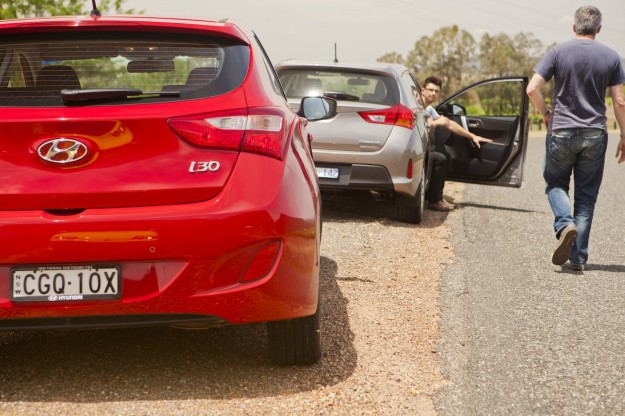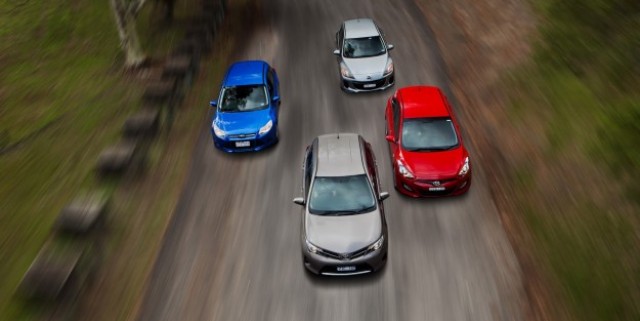
With an all-new Toyota Corolla launched with a $19,990 price tag, we find out which is the best entry-level small car for the money, putting the world’s best selling small car up against the Ford Focus, Hyundai i30 and Mazda3. Words: Daniel DeGasperi. Photos: Easton Chang.
Comparison tests don’t come more relevant than this. One in five Australian new-car buyers choose a small sedan or hatchback. And out of the 29 class contenders in the sub-$40,000 small car segment, more than half buy a Mazda3, Toyota Corolla, Hyundai i30 or Ford Focus (in that order). Quite simply, we’ve rounded up the newest (Corolla and i30), most popular (Mazda3), and best-driving (Focus) small cars that Australians actually buy.
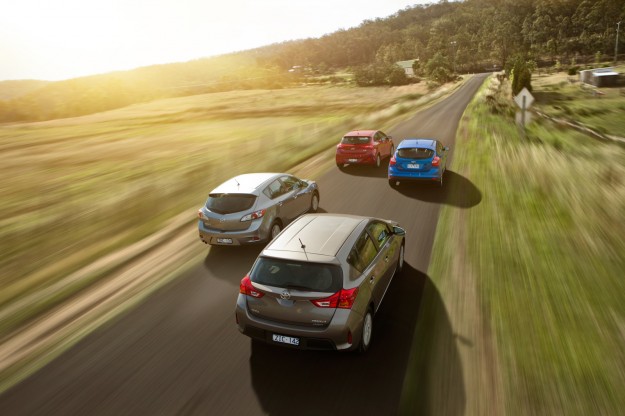
A few years ago the Mazda3 surpassed the Corolla as the number one selling small car. Last year, the Hiroshima-built contender performed a swift overtaking manoeuvre on the Holden Commodore to move into position as this country’s best-selling car overall – the locally built Lion had held firm in the right lane since 1997.
But the 3 is now three years old, and there’s a brand new Corolla on the grid wanting pole position in both the class and country. Toyota dropped a bombshell with this 11th-generation model by reducing the entry sticker by $1K, so the base Ascent manual now sits at the mid-1990s throwback price of $19,990. Hopefully another switch back to the era of Nike pumps and Discmans will see a return of the Corolla fun factor. Yes, Toyota claims the new Corolla is “more fun to drive” but it kinda does that with every generation. What we want to see, even in this base, hubcap-equipped Ascent, is a return to the spirit of the 1980s 100kW SX, as showcased spectacularly well by the 86 coupe.
It should be so, because the Focus delivers class-benchmark steering and handling, even wearing its hubcaps. The fourth contender, the i30, won’t widen the driver’s smile, but it does keep the Korean company grinning thanks to its popularity. It’s also the second-newest contender here.
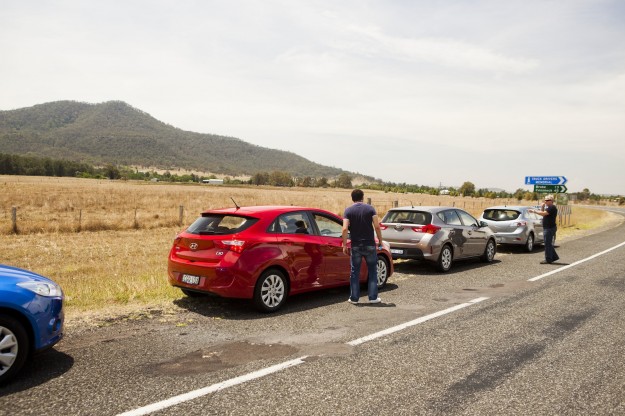
Other fresh competition such as the Opel Astra and Subaru Impreza can’t match the Corolla’s keen pricing, while the still-formidable Volkswagen Golf will be replaced in April. Which leaves this awesome … okay, it’s just a foursome.
Although the test target is $20,000, our cars all add $2K for an automatic transmission. The newly launched Corolla is yet to feature driveaway discounting, so the 1.8-litre petrol, auto-equipped Ascent hatch costs $21,990, or about $25,500 on-road.
Cheapest of the field, with the smallest engine, is the Focus, the 1.6-litre, six-speed dual-clutch-equipped variant charging $21,990 driveway. Add $1K for the Mazda3 Neo with 2.0-litre four and five-speed torque converter auto, and another grand for the Hyundai i30 Active with 1.8-litre four and six-speed auto.
The entry-level models are bread and butter without much filling. Only the Mazda gets alloys, but wraps them in 15-inch rubber, while the others get 16-inch steel wheels. The Ford is the only model to lack cruise control, but singularly gets voice control. The Hyundai uniquely features seven-inch touchscreen audio and foglights. All include power windows and mirrors, CD stereo with Bluetooth audio, and trip computers. Call it an early value win to the second-cheapest, alloys-equipped Mazda (below).
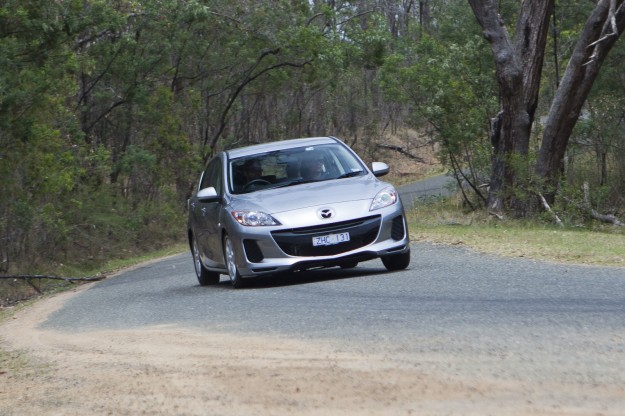
Unfortunately the Mazda3 is also the most expensive to service. Like the Corolla, it has six-month/10,000km intervals, except where the Mazda’s first six services costs $2200, the Toyota’s totals $780, thanks to the company’s capped-price program.
Hyundai and Ford offer fixed-price check-ups, too, though the i30 and Focus have annual/15,000km intervals, totalling $960 and $657 over three years. A win for the Koreans, initially, but the i30 needs its timing belt changed at 90,000km, at a cost of … $1080. That makes it the most expensive to service over six years.
Thankfully the i30 is efficient in other areas. The Hyundai clean-sweeps the quartet by offering the nicest interior quality, best cabin packaging, and benchmark refinement. Its 378-litre boot is the largest here, 38L bigger than Mazda3, 62L larger than Focus, and a whopping 98L more capacious than Corolla. Yet it also offers a tilted, supportive rear seat base and the most rear legroom. (Below, top to bottom: i30, Mazda3, Focus, Corolla).
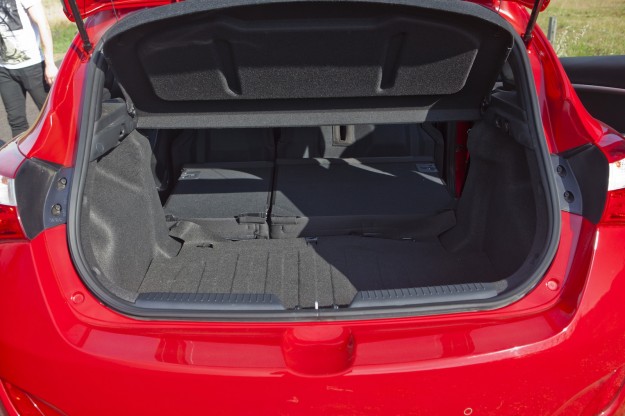
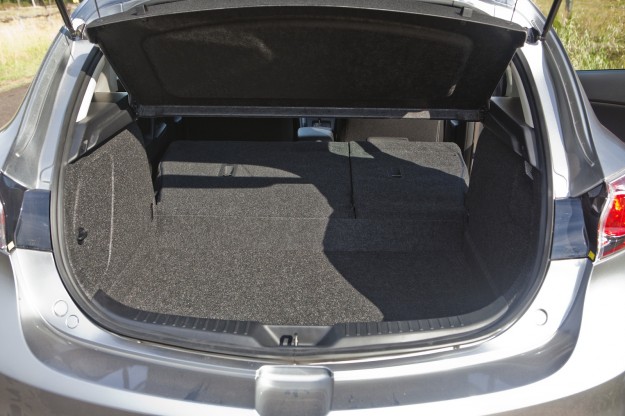
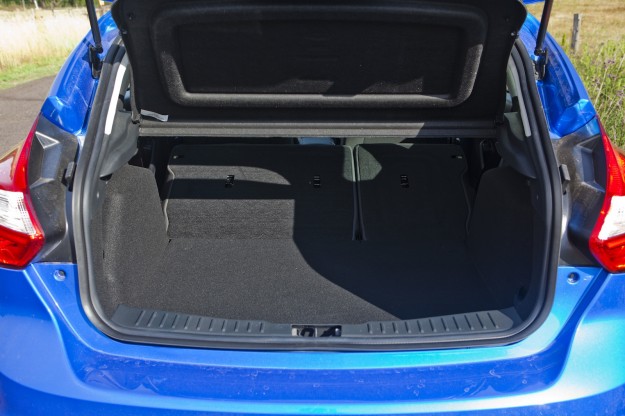
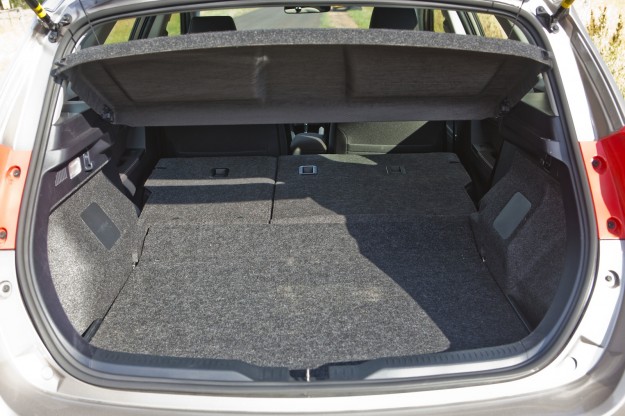
The tape measure says the i30 lines up identically with the Toyota, offering 240mm of legroom (to the driving position of a 5ft 8in driver) compared with the Focus’s 220mm and Mazda3’s disappointing 180mm.
The 3’s rear accommodation is also hampered by a short and flat bench; the Focus has wonderfully soft seats, and the Corolla matches the i30’s chunky side bolsters. (Below, top to bottom: i30, Corolla, Focus, Mazda3).
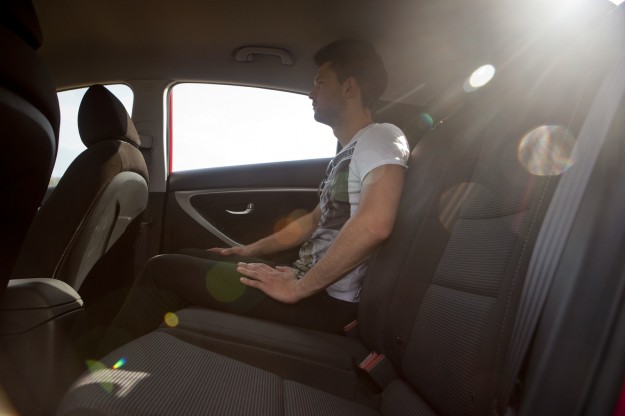
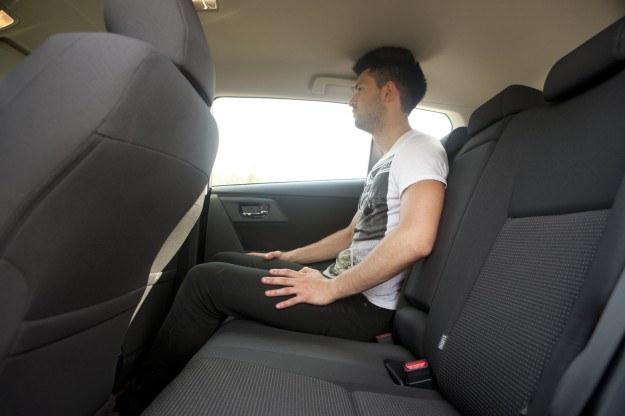
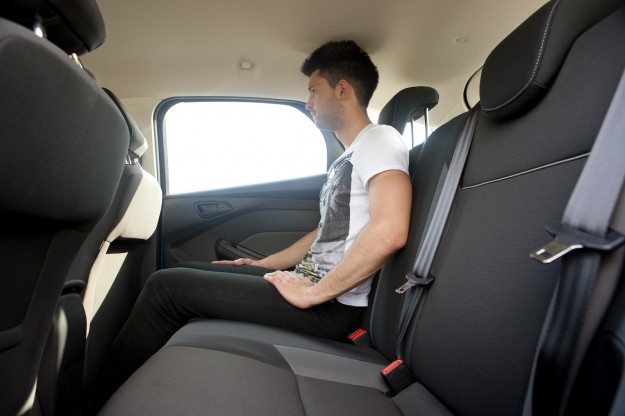
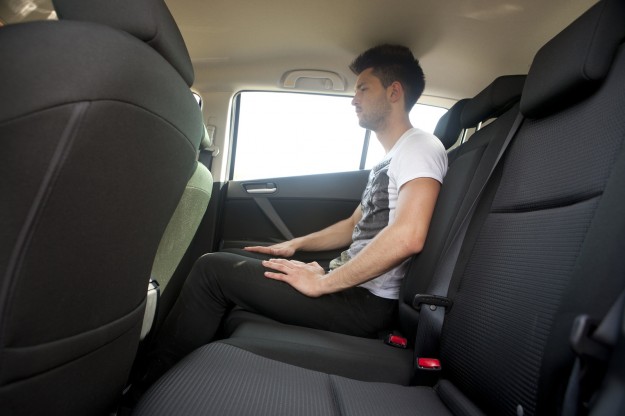
Ford’s interior is a mish-mash of cheaply finished plastics, switchgear styling derived from a 1990s Nokia, and lurid green displays.
The mismatched plastics in the Mazda3 are easier to accept because all of them are of a higher standard, and its switchgear is more ergonomic.
With faux-aluminium trim, proper door grabs and a slab-sided dash, the Corolla looks the most outwardly – wait for it – sporting, and is backed by quality plastics almost to i30 standards.
The Hyundai simply offers the nicest trim and textures, and a high-quality colour touchscreen that immediately relegates the other pixelated assortments to the last century. (Below, top to bottom: Focus, Mazda3, Corolla, i30).
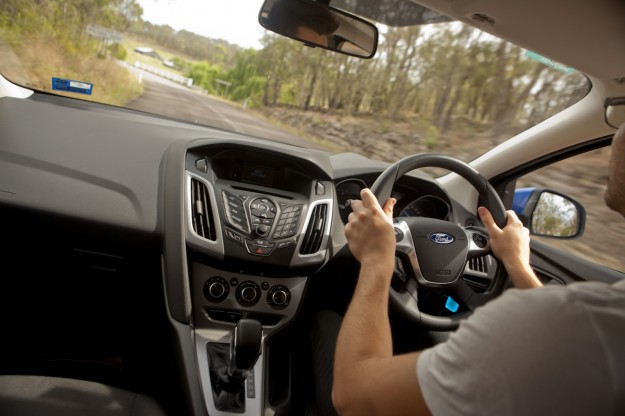
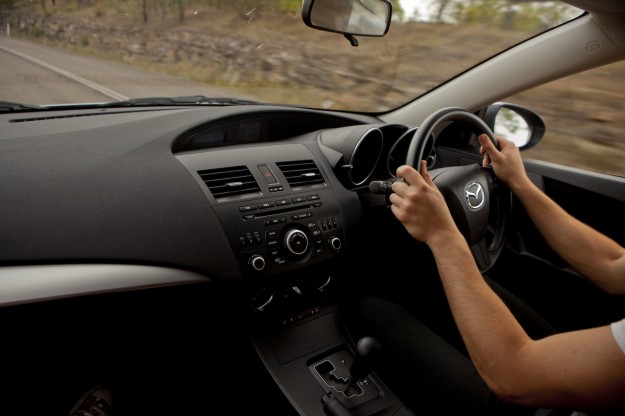
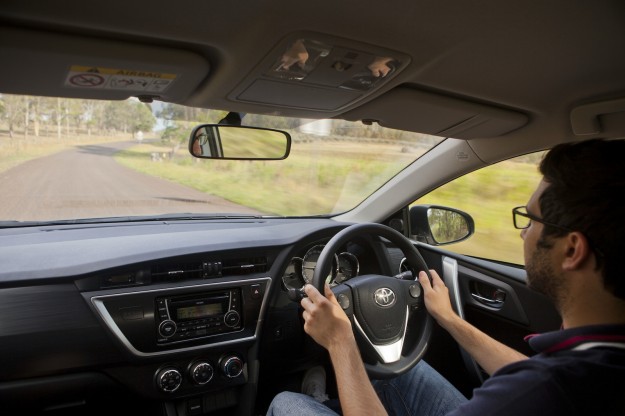
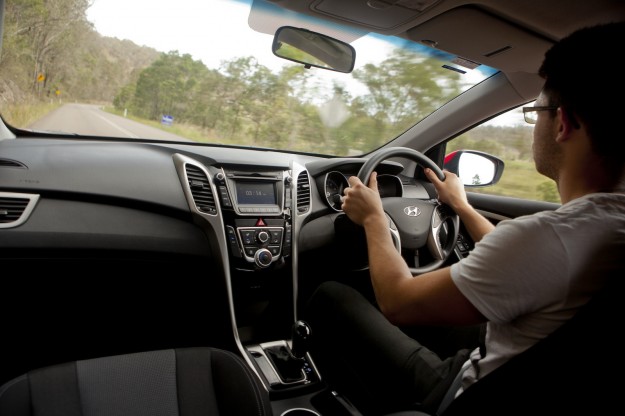
All four cars share naturally aspirated, four-cylinder petrol configurations, with swept capacity neatly spaced between 1.6- (Focus), 1.8- (Corolla and i30) and 2.0-litres (Mazda3).
With 92kW and 151Nm, Ford’s unit offers competitive outputs considering its capacity, however the keen engine (below) is hampered by a 1311kg kerb weight – the Focus is 48kg heavier than the i30, adds 61kg over the Corolla, and is a large bloke’s worth (86kg) weightier than the Mazda3.
Its six-speed dual-clutch gearbox, dubbed PowerShift in Ford-speak, is presented with the huge task of juggling ratios between peak torque (at 4000rpm) and maximum power (at a heady 6400rpm). Around town, the gearbox is unacceptably jerky, especially when cold. Yet it isn’t particularly quick to kickdown ratios when the throttle is slammed. Asking a small engine, without a turbocharger, to power a heavy car is akin to putting bricks in a child’s school bag.
The Focus doesn’t feel tortured, not by DOCS standards anyway, but the others feel frisky by comparison.
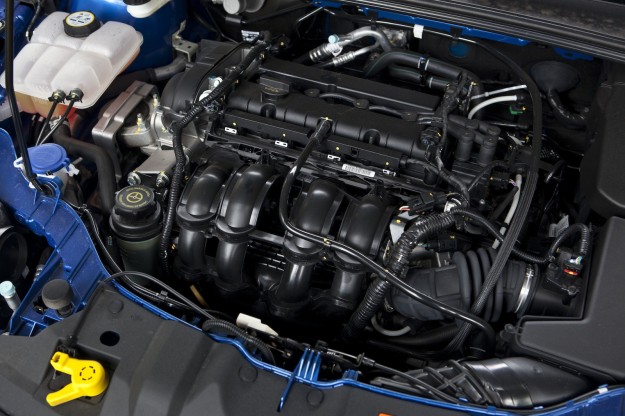
Lightest and strongest-performing of the group is the Mazda3. Its 2.0-litre produces 108kW and 182Nm, and teamed with a five-speed torque converter auto, they make for a pleasant drivetrain combination.
The auto is the star here – it slurs smoothly between gears, yet kicks down decisively. It needs no gimmicky ‘sport’ button because the electronic mapping is intelligent enough to subtly grab a lower gear when braking downhill, and hold those lower gears when punting through corners.
Its tipshift manual facility is, uniquely among this lot, the correct way around (push the lever forward to downshift) and doesn’t automatically upshift at redline. The Mazda engine (below) doesn’t sound particularly inspiring – it’s loud and grainy – but that is its single issue.
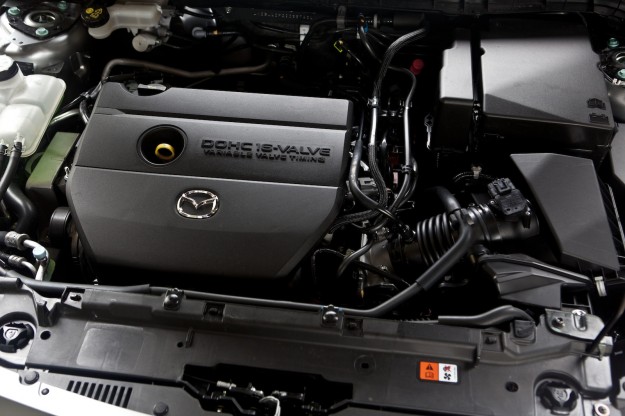
Hyundai’s in-house six-speed automatic matches the Mazda’s smarts, and in more ways it needs to.
The 1.8-litre engine in the i30 needs 4700rpm showing on the tacho before its maximum 178Nm is delivered. Much below that, the engine lacks torque, but like a long-married couple the auto understands the flaw of its partner; apply light throttle on hills and the gearbox (oh how the Focus needs this) quickly drops gears to disguise the deficit.
Head towards 6500rpm, when peak power is delivered, and the Hyundai engine (below) is the sweetest of the quartet, keen and quiet at the top end.

For an engine that debuted more than a decade ago, in 2001, the Toyota 1.8-litre is still a surprising force. It’s a tractable toiler more than a high-end screamer, but is competent in all areas. Effective but uninspiring is a description that fits the engine as much as the continuously variable transmission.
Surprisingly, the CVT is at its worst in the suburbs, where it slides up and down the rev range, flaring revs or holding them high under full acceleration to the detriment of engine refinement. Toyota claims a 10 second 0-100km/h time, which feels about a half-second slower than the Mazda, bang-on with the Hyundai, and a couple of seconds faster than the Focus.
Out on twisty roads, the seven ‘preset’ gears, accessed via the manual tipshifter, help make the CVT the sportiest gearbox here, with tightly packed ‘cogs’ that keep the 1.8-litre engine (below) closer to 6400rpm, where its peak 103kW is developed.
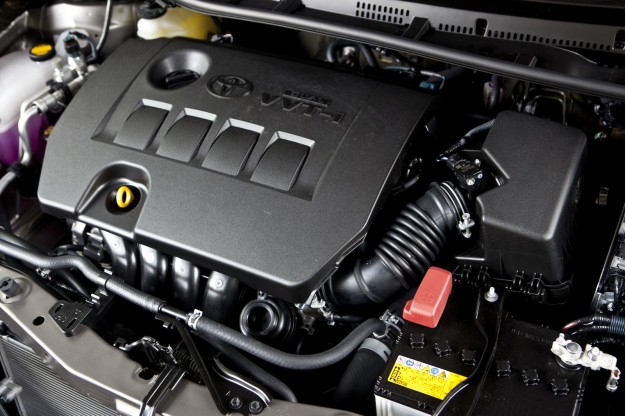
That’s a fine thing in this 11th-generation Corolla, because when the bitumen turns bendy this Toyota is … fun. More than that, the new Corolla turns in keenly, sits flatly, is firmly disciplined, and reveals surprising balance.
As with the CVT, the electro-mechanical steering is at its worst around town, where its Aurion-sized vacancy on centre is most noticeable. It creates a fiddly nervousness in the first movements that even commuters – not just enthusiasts – will find annoying.
Ride quality isn’t as plush at it should be, either, and it takes only a swap into the Focus to realise Toyota still hasn’t played with ride and steering benchmarks. Nor is the stability control sophisticated, clamping on corners hard and early.
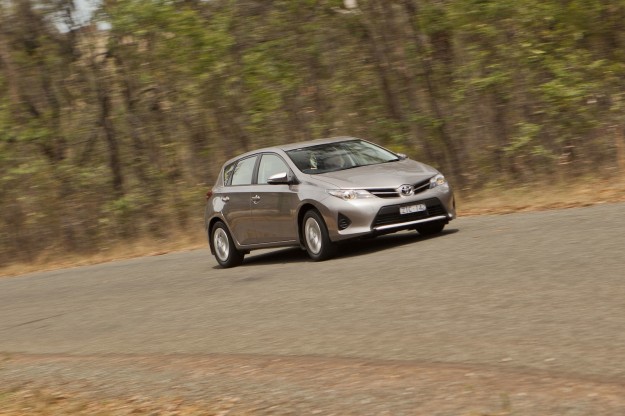
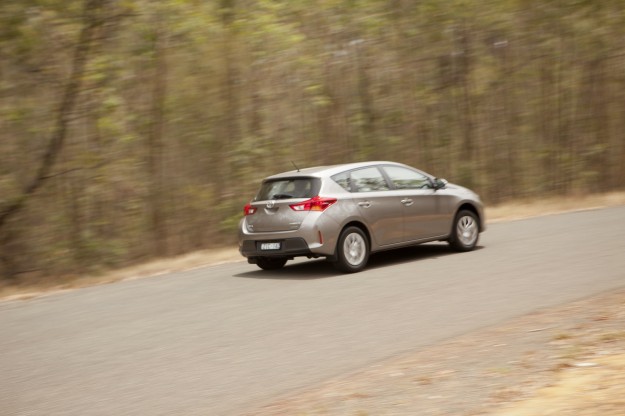
The Ford is actually softer than the Corolla, both in terms of body roll and even seat comfort. That’s no problem, however, because the chassis offers exquisite balance, mixed with triple-ply absorbency on all roads.
The steering, the single hydraulic set-up of the group, is light, progressive and feelsome.
Not all small car buyers value steering and handling, but the real masterstroke with models like the Focus is their ability to involve and excite the driver without negative impact to the ordinary motorist. Its dynamic ability is simply broader than the others.
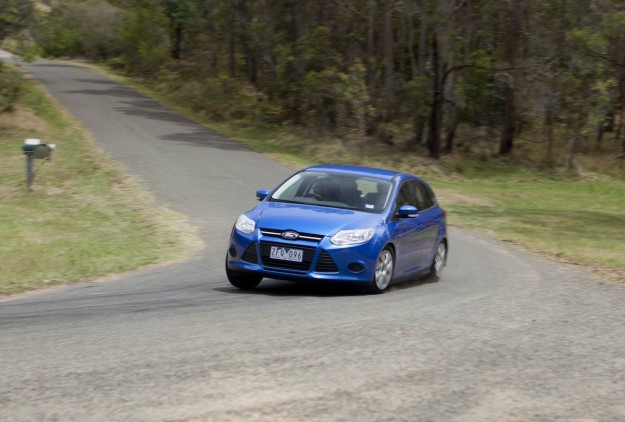

In outright handling terms, the Mazda3 is still the one. Its steering isn’t quite as measured as the Ford’s, but it is still wonderfully light, sharp and slick – several turns better than Corolla and i30 in this regard.
The Mazda darts between bends, its tyres giving up before the chassis wants to. Lift the throttle through the corner and the 3 segues into mild oversteer. The stability control calibration is also the best here, subtle but sure. The 3 is possessed of a truly wonderful chassis, but we wonder how many of its many buyers appreciate it.
Most would probably prefer a calmer ride and a quieter cabin, because the lumpy suspension – even on the Neo’s chubby tyres that should help the ride – and loud roar on coarse chip surfaces are the Mazda’s only vices.
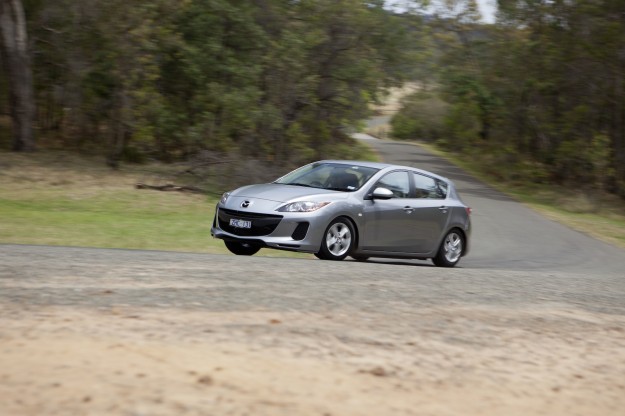
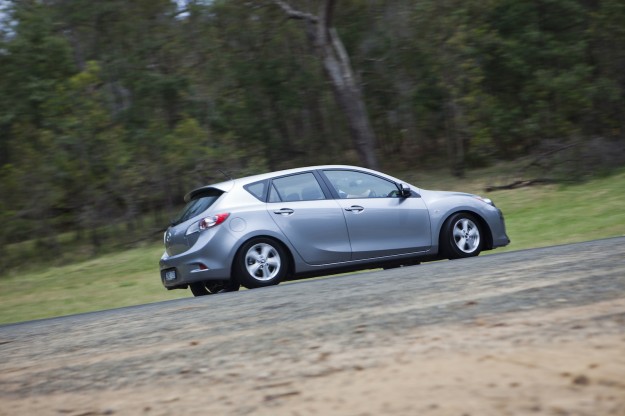
Hyundai is the big improver in suspension-tuning terms. The i30 is the softest car here, with the most body lean, and is the earliest to push into squidgy understeer. However both its ride compliance and chassis balance are quite good.
It is also the quietest car here, by good margin over the Mazda and a decent few decibels compared with the Toyota and Ford. Only those pushing on will find the lack of finesse disconcerting – the torsion beam rear suspension hops and skips over large bumps that the others steamroll, and the stability control is the most aggressive in operation.
The steering offers three modes – Comfort, Normal and Sport – which each alter only the weight of the tiller. Unfortunately, the settings represent the equivalent of wading through cold water (Comfort) or stropping through mud (Sport) – neither of which are particularly pleasant. The i30 steering offers greater on-centre precision than the Corolla, but that’s about it. Ultimately, in engineering terms, the Hyundai still lacks final polish.
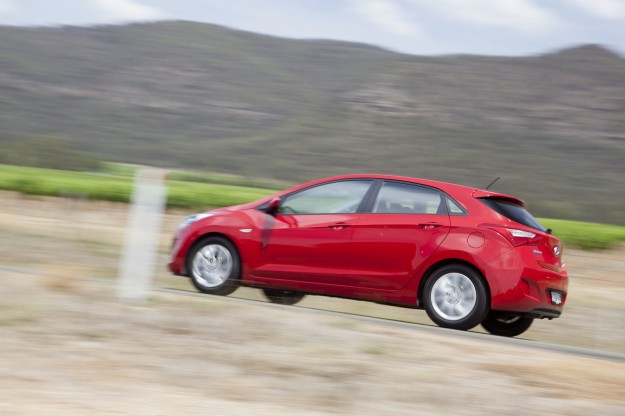
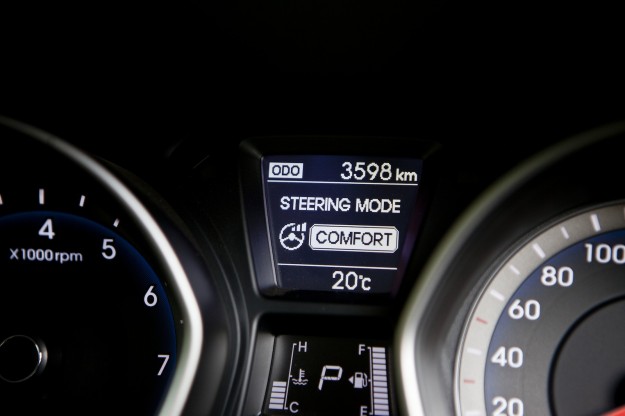
The Mazda, like the Ford, feels like a quality product more in the bits you can’t see than the bits you can. But where the base Focus is hindered by the least-convincing cabin and drivetrain in this group, the 3 wins this group test because it offers a high-quality cabin and the best drivetrain here. Interestingly, but unsurprisingly, the need to thrash the Focus meant it slurped the most fuel – 10.6L/100km on test, compared with 10.5L for the Toyota and a flat-10.0L for both the Hyundai and Mazda.
Choosing between the Corolla and i30 for the silver is difficult. The Toyota is surprisingly good fun, cheap to service and obviously well made. Yet the Hyundai offers the best cabin, refinement, and packaging of the four, but not markedly inferior dynamics.
Ironically, considering it’s the nation’s favourite car, the Mazda3 is a car more for the driving enthusiast minority than the majority of motorists. You’d actually expect the quieter, calmer-riding Hyundai i30 to be more appealing to the masses.
